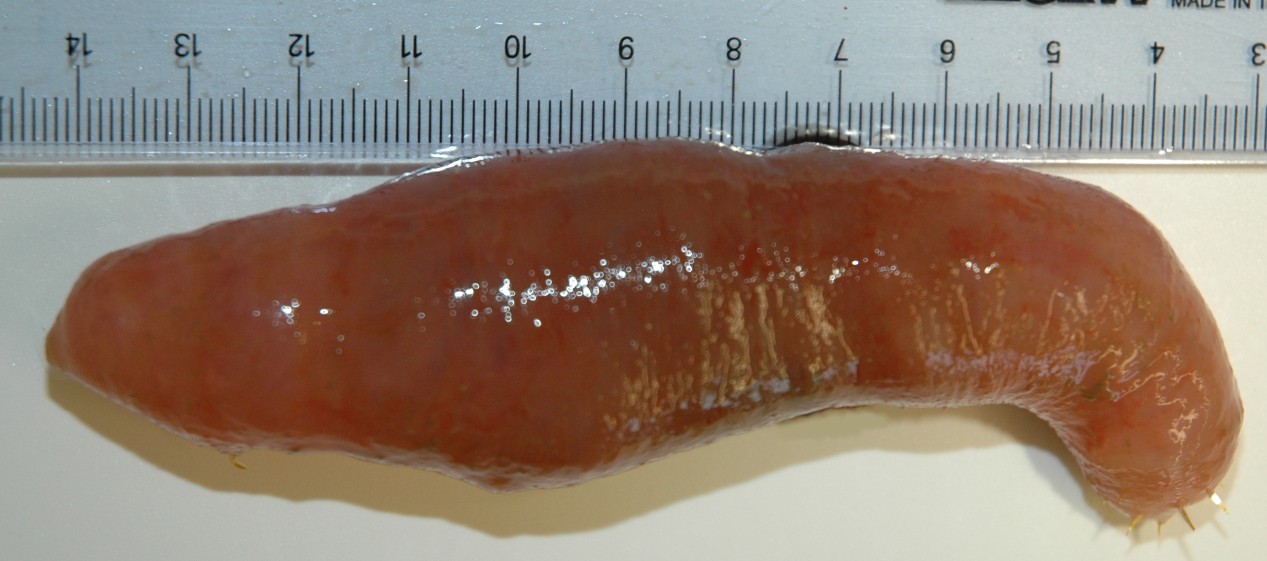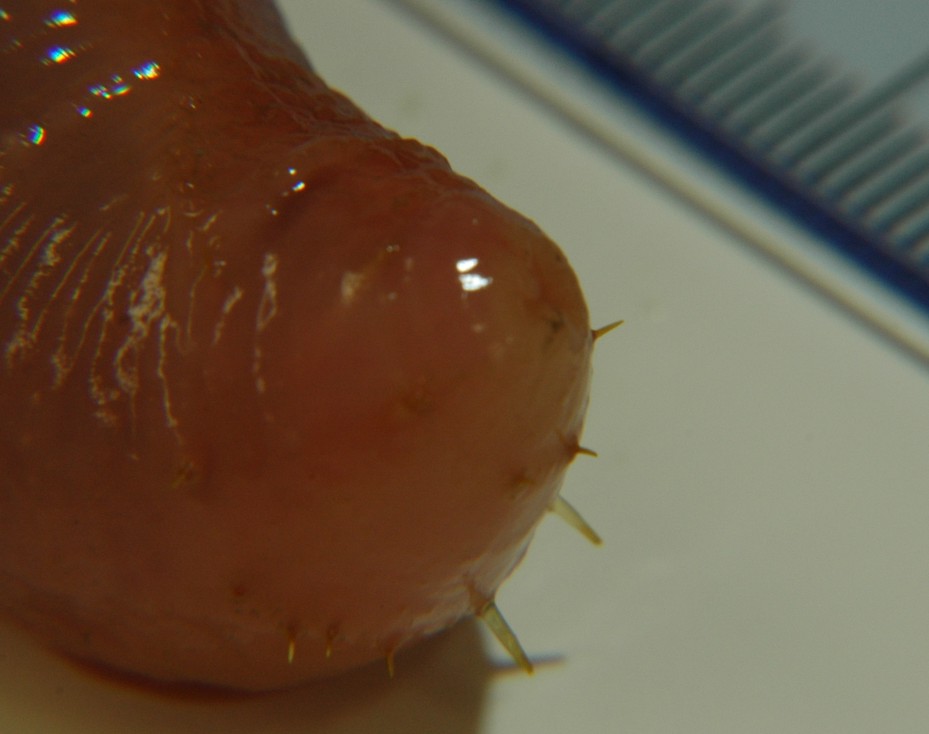Echiurus echiurus subspecies alaskanus Fisher, 1946Common name(s): Alaska Spoonworm, Fat Inkeeper |
|
| Synonyms: |  |
| Phylum
Echiura
Class Order Echiuroinea Family Echiuridae |
|
| Echiurus echiurus subsp alaskanus, captured at 100-150 m depth in San Juan Channel. Scale is in cm. | |
| (Photo by: Dave Cowles, July 2005) | |
How to Distinguish from Similar Species: This is the only local species that has two rings of setae on the posterior end.
Geographical Range: Point Barrow, Alaska to Auke Bay, Alaska (or Puget Sound, WA). Orbis shows this subspecies range only in SE Alaska, and the range of Echiurus echiurus being in SE Alaska + Scandinavia.
Depth Range: Mid to low intertidal and subtidal
Habitat: Under cobbles and boulders in areas where mud accumulates. The individual above was caught by otter trawl on a flat, shelly-hash bottom.
Biology/Natural History: Males and females look similar in this species. Probably a deposit feeder. The alaska spoonworm is said to have a proboscis that is not easily detached, whil E. echiurus spbspecies echiurus has a proboscis that is easily detached. Since the proboscis apparently readily detched in the specimen above, it may be subspecies echiurus, though Kozloff does not list that subspecies as being found in our area. Echiuroids usually have a thin-walled portion at the rear of their digestive system, and are one of the few species (such as sea cucumbers) that breathe through their anus.
A "mystery" piece of tissue was collected in the same trawl with this worm, which may very well be its proboscis, though the anterior end showed no obvious scar where the proboscis may have detached. The tissue was about 3 cm long and slightly smaller diameter than the worm. It was curled into a trough shape on one end and appeared nearly cylindrical on the other end. It had a velvety, dark red interior and an orange-red exterior, somewhat more orange-red than the animal's body.
The following description of burrowing in a related Echiuran (Echiurus pallassii, an east coast species) is by C. B. Wilson, excerpted from Johnson and Snook, 1955: "The animal rests upon its ventral surface, thus bringing its two large anterior setae in contact with the mud. The proboscis is turned upward and backward and remains thus with its edges somewhat rolled in and takes no part in the burrowing. The anterior end of the body is made wedge shaped, the under surface flattened and extending forward with the two setae projecting from its anterior edge. These are thrust into the mud and then the hinder part of the body is drawn forward. This is anchored by the anal bristles and the anterior end is pushed still further down into the mud. The process is described as being very slow, taking 40 minutes to get the body out of sight below the surface. The burrow goes down diagonally 10-18 inches, then horizontally 6 inches to 2 or 3 feet and then vertically to the surface. Once at the surface, the anterior end comes out far enough to free the proboscis and get it in its normal position, and then the body is withdrawn. Mud washes into the unoccupoed parts of the burrow, but an opening the size of a lead pencil remains, through which the proboscis is thrust in search of food when the tide is in. The proboscis may extend to a length of 5 or 6 inches. When a piece of food is located, the proboscis rolls to form a tube, and the inner surface being ciliated, a current is produced which carries the food into the mouth."
| Return to: | |||
| Main Page | Alphabetic Index | Systematic Index | Glossary |
References:
Dichotomous Keys:Kozloff 1987, 1996
General References:
Johnson
and Snook, 1955
O'Clair
and O'Clair, 1997
Scientific Articles:
Interner links:
Orbis
range
maps: Search for Echiurus
General Notes and Observations: Locations, abundances, unusual behaviors:
I have only clearly identified this species once (2005) in otter trawls from San Juan Channel. I may have seen it before but not recognized it as an echiuran.

The anterior end of echiuran worms has two hooked setae on the ventral
side, as visible here.

The posterior end of Echiurus echiurus has two
nearly complete
rings of setae.
Authors and Editors of Page:
Dave Cowles (2005): Created original page